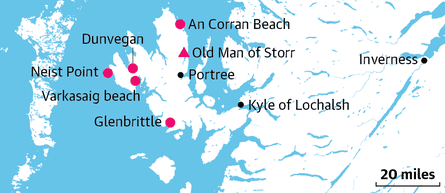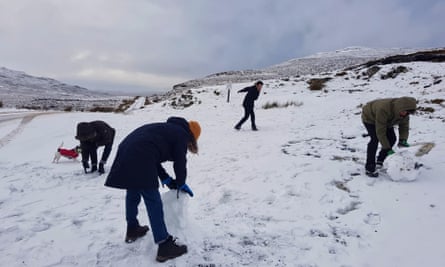Winter Skye: the snow, wind and rain made our trip to Scotland a euphoric experience

By Guardian - Matt Gaw - Mon 16 Dec 2024 05.00 GMT
Winter on the Scottish isle is a thrill for our writer, a reminder that the ‘bad’ elements can be as exhilarating and restorative as sunshine. It had been hard to judge the wind’s strength. On the Isle of Skye there aren’t many trees to bend, and despite the low temperatures the chimneys of the few white-washed crofting cottages we had driven past on the way to the western tip of the island were not smoking.
But as soon as we parked at Neist Point, it was obvious it was blowing a hoolie. Water is meant to fall downwards, yet all along the step of the cliff that bends away to the east, the run-off from rain and snowmelt was being flung into the air in spindrift fountains.

As soon as we got out of the car the wind was there with us. It shouted jet engine-loud in the shells of our ears. It pushed against our chests and plugged our breath with its own. We gasped with the shock of it, and then, just as suddenly, we laughed. We planted our feet and leant into the wind and tried shouting at each other. Look, we motioned to each other, we are being supported, we are being carried.
At primary school I remember how we were banned from practising “black magic”: a game where a group of us would try to lift a friend up with just our little fingers while chanting, “light as a feather, stiff as a board”. On this cliff-top, the wind contained the same dizzying magic. We were suspended in the air. Leaning. Our weight held at an impossible angle. Held up by nothing.

Not far from the road was a path, marked by bollards, that led down to the headland and – somewhere beyond the gigantic, upstanding crag of An t-Aigeach – the lighthouse that we had come to visit. The low glow of a December sun cast a light that seemed to have been frothed by the wind over the muscular ridge of rock, while a sea the colour of old ice smashed itself to pieces on the black of the basalt rocks. The spray smoked up from below, as if Skye had suddenly been made volcanic again.
There were six of us (plus a slightly resistant jack russell) on the walk that Christmas Eve. My wife, Jen, my children Seth and Eliza and our close friends James and Anna. We had come north for the holidays, staying in a cottage that faced east towards the black sands of Varkasaig beach (known locally as Orbost). Not far from Dunvegan, with its 13th-century castle, deli and restaurant, but isolated by two miles of teeth-rattling track, it was a location that was comfortably remote. A place where we could relax, talk, walk and take bracing swims in the tidal waters of Loch Barcasaid before warming our bones in front of a crackling wood fire and watching the weather blow in off the sea.
Could weather we disregard and shun actually turn out to be luminous and nourishing if only we open up to it?
Because, after all, it was the weather that had led me to this spot on the Isle of Skye. It was here that, honed by the sea and the business end of winter, I hoped to find what would usually be described as the very worst kind of British weather.

It was during the heatwave of 2022, a time I started longing for rain, that I realised my relationship with weather had become lopsided. I had, however unconsciously, started to view sunny weather as good and everything else as, well, bad. In some ways, it’s an understandable narrative. The sun boosts feelgood hormones, serotonin levels and gives us vitamins. From an early age, as soon as a fist can hold a yellow crayon, we see the sun as a symbol of beaming happiness. We worship it. We bathe in it. And then, when winter comes and our world tilts away from it, some of us even chase it across hemispheres, travelling thousands of miles at great expense to feel its goodness, to warm our hard-working bones.

But what if we could find equal joy in other weather? If we could learn to also appreciate the beauty of the rain; the wild freedom of the wind; the dazzling play of light sparking off haw frost or the otherworldly enchantment of fog. Could weather we disregard and shun (by which I mean weather we might think of as “miserable” rather than life-threatening or home-swamping) actually turn out to be luminous and nourishing if only we open up to it?
Walks, just like this one at Neist Point, were an attempt to redress the balance and helped me realise that all types of weather – our most talked about natural phenomena – can be sublime, beautiful and yes, fun.

Certainly, my experience of walking, running and swimming in a heatwave-breaking storm, a shower, the frontal downpour over Cumbrian crags, or a day of drizzle, has shown me that there is little sadness in rain. In fact, it feels like the opposite. There’s a lightness, a joy in experiencing something utterly fundamental about the world. It is a feeling backed up by science. Because when the clouds burst, there is something other than water in the air; negative ions are atmospheric molecules charged with electricity. They are most abundant around places like rivers, beaches and mountains, where air molecules are broken up by moving water. They are found near breaking waves, by waterfalls and they are there, too, when it rains.
But as a teacher, wind is more feared than any wet break. It does something to the children; fills them with energy and leaves their brains clinking away like ships’ masts. Physiologically, there is evidence that the wind changes us. Adrenalin production increases, the blood vessels of the heart dilate, increasing blood flow and oxygen supply. Pupils widen, the skin contracts, forcing hairs to stand on end. The body prepares for fight or flight. No one is really sure why we’re so sensitive to the wind. Some suggest it is an evolutionary throwback – a state of high alert to conditions that could mask the approach of predators or threaten shelters, life and limb. Staying in the wind maintains that state of emergency. Yet, to us, it doesn’t feel like stress at all. It feels almost euphoric.
Watching the crepuscular light turn the snow of the Cuillin mountains gold certainly felt more warming to the soul than lazing on any sun lounger
On Skye, we felt something similar. We clambered up on rocks to take photos of each other gooning around, leaning into the wind, standing on the rocks with our arms wide, as if we were on the prow of a ship rather than this prow of rock. We took videos of the crash and thunder of the sea, recordings filled with light and movement and a roar that sounds like rocks being ground by teeth.
It reminded us of the podcasts we had listened to on our drive to Scotland: dramatisations of famous hauntings, modern accounts of things that are ghostly and strange. Seth and Eliza, hair whipping across their faces, were standing facing the sea, their eyes closed, their mouths open as if they were being filled up from toe to tip.
There was a magic to that day, to that moment. I felt it too when we swam in the Fairy Pools near Glenbrittle: a system of glacier-carved waterfalls where the pools are deep, clear and burning with cold. As we got dressed, shivering and shaking off the snowflakes that had started falling while we were in the water, we saw we had the place to ourselves. A landscape that can fill with people in summer (the problem of excessive tourism is a regular discussion point in the local press) had been emptied by the weather.

The same was true when we drove north-east across the island. At one point we stopped the car to have a snowball fight on an empty road fringed with sparkling, scalloped drifts. On the beach at An Corran, we were the only souls searching for dinosaur footprints under the watery arch of a sleetbow. Even at the Old Man of Storr on the Trotternish Ridge (one of the island’s busiest attractions) the number of visitors could be counted on one hand – something that added to the location’s wild, craggy, beauty.
Perhaps the relative solitude of Skye helped me notice more: to tune in and soak up every second with my friends and family. The quiet, along with the weather, helped me be present in a way that was truly restorative. What I do know is that standing with my loved ones watching the crepuscular light turn the snow of the Cuillin mountains gold, certainly felt more warming to the soul than lazing on any sun lounger.
Matt Gaw’s book, In All Weathers, is published by Elliot & Thompson (£14.99). To support the Guardian and the Observer order your copy at guardianbookshop.com. Delivery charges may apply.
